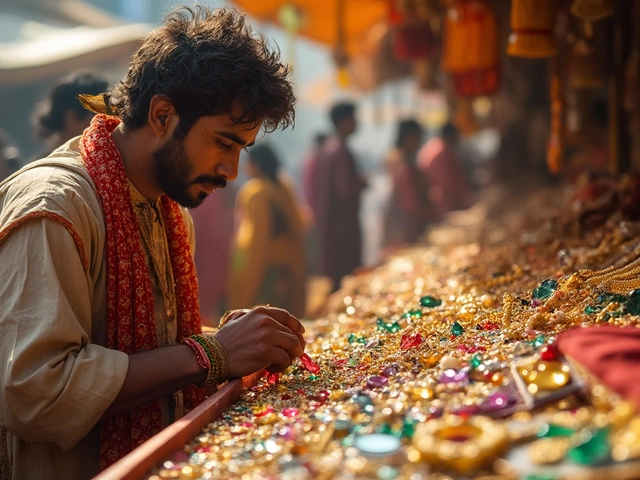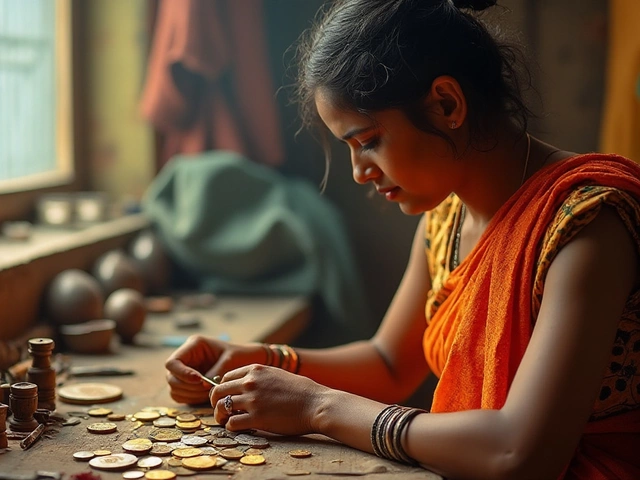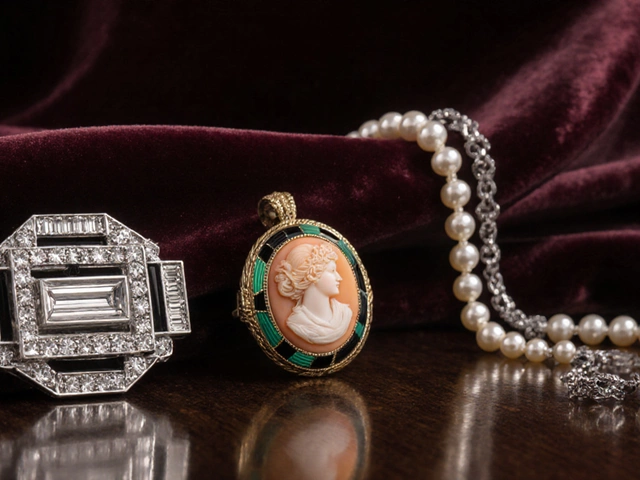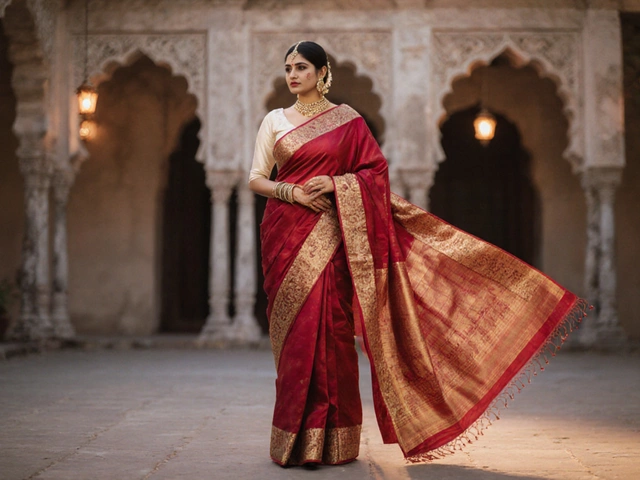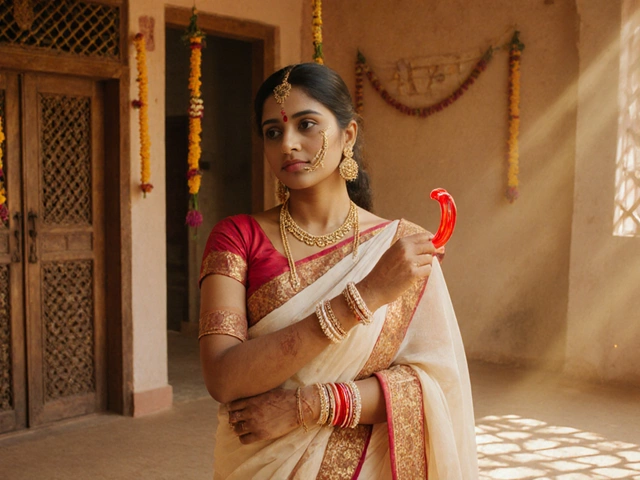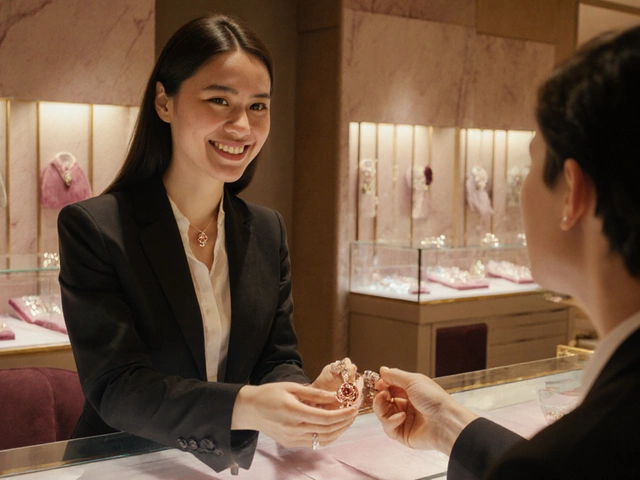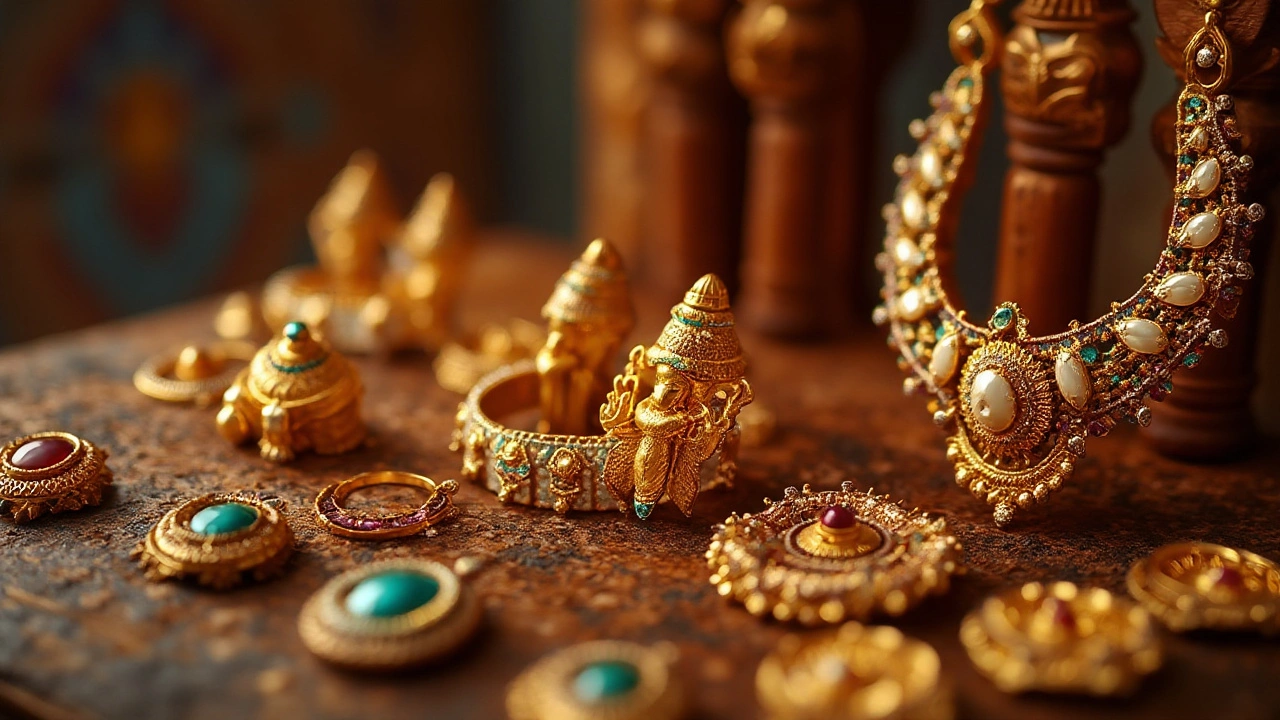
Nakashi jewellery holds a special place in the realm of traditional Indian adornments, drawing inspiration from the resplendent designs that adorned ancient temples. It is more than just ornate pieces; it encompasses a rich tapestry of history, culture, and spiritual significance that dates back centuries.
Steeped in symbolism, this type of jewellery showcases intricate handwork that requires immense skill and patience. Incorporating iconic depictions of divine figures and mythological narratives, Nakashi jewellery is cherished for its artistic glory and devotion-filled themes, making it highly sought after by collectors and enthusiasts alike.
- The Origins of Nakashi Jewellery
- Cultural Significance of Temple Jewellery
- Design Elements and Craftsmanship
- Materials and Techniques Used
- Modern Inspirations and Uses
- Tips for Purchasing and Care
The Origins of Nakashi Jewellery
Nakashi jewellery, a remarkable facet of India's cultural heritage, boasts a history intertwined with the spiritual and artistic traditions of ancient Hindu temples. This exquisite form of temple jewellery has its roots deeply embedded in the southern regions of India, where art and spirituality have historically walked hand in hand. Traditionally, these opulent pieces were crafted as offerings to adorn the deities housed in grand temples, revered by a community that found solace and inspiration within these sacred spaces. As the centuries passed, the intricate designs of Nakashi jewellery evolved, preserving the aesthetic essence while embracing new patterns and styles.
The symbiotic relationship between religion and art in India paved the way for the creation of jewellery that served both decorative and divine purposes. Early artisans, skilled beyond their times, drew inspiration from the iconography found in temple architecture, carvings, and scriptures to produce designs that were replete with symbolism. Kings and queens wore these unique creations not only as a sign of their devotion but also as a testament to their wealth and taste for fine art. Over time, the production of Nakashi jewellery was not just limited to temples and royal courts; it permeated various strata of society, becoming a cherished heritage passed through generations.
An interesting fact about Nakashi jewellery is its continuous lineage of traditional craftsmanship, where skills are imparted over generations within artisan families. The ancient technique of lost-wax casting, among others, ensured that each piece was unique, bearing the exquisite touch of the master crafting it. During the Chola Empire, approximately from the 9th to 13th centuries, there was a notable expansion in the production and application of temple jewellery, with many pieces created for temple dancers, adding to their grandeur and stage presence.
"The essence of Nakashi jewellery lies in its ability to narrate stories from mythology, an art form that transcends mere beauty," observes Anjali Anand, a renowned historian of Indian art. Her insights echo the sentiments of many who delve into the history of these intricate masterpieces, marvelling at their capacity to blend artistic elegance with historical narratives.As the modern era embraced traditional aesthetics with a contemporary flair, the timeless appeal of Nakashi jewellery surged, captivating audiences both in India and abroad. While preserving its ancient artistry, Nakashi jewellery has found new interpretations and adaptations, ensuring its relevance and popularity today.
Below is a simplified timeline showcasing the evolution of Nakashi jewellery over significant periods:
| Time Period | Key Developments |
|---|---|
| 9th - 13th Century | Chola Dynasty promotes temple jewellery; patronage for temple dancers |
| 1400s - 1700s | Echos of Mughal influence; royal courts adopt Nakashi designs |
| 1800s | Colonial influence alters materials and fashion, though traditional roots remain |
| 21st Century | Revival and globalization of Nakashi jewellery; combines tradition with modernity |
Cultural Significance of Temple Jewellery
Temple jewellery, revered as much for its breathtaking designs as for its deep cultural roots, serves as a profound expression of India's historical and spiritual heritage. Originating from the grand, ornate temples of South India, these exquisite pieces were initially crafted for adorning deities, emphasizing the intersection of art and religion. Such jewellery holds a special place in cultural rituals and festivities, often seen as a bridge that connects the divine and the human realm through its symbolic and aesthetic appeal.
The cultural significance of temple jewellery lies not only in its religious connotations but also in its role in marking significant life events such as weddings, festivals, and religious ceremonies. It is traditional to share jewellery pieces, like the intricately designed Nakashi jewellery, during cultural rites, where each design encapsulates powerful stories from Indian epics and mythology. Artisans devoted countless hours to handcrafting these pieces, ensuring each one resonated with spiritual symbolism and historical authenticity.
These visuals of divine entities, like gods and goddesses depicted in temple jewellery, provide a narrative of spirituality and devotion, elegantly told through the medium of precious metals and stones. The alignment of these designs with Hindu iconography underscores their intent and significance. This jewellery series serves as educational tools, imparting tales of divine prowess and mythology even to those who are less familiar with these cultural contexts. It is powerful to note how in today's world, the traditional and artistic integrity of this jewellery continues to uphold its status as both cultural and fashionable staples.
"The intricate designs of temple jewellery are not just an art form; they are a deep-seated communication of cultural narratives," says Dr. Radhika Gupta, a renowned historian on Indian adornments.
Furthermore, the importance of preserving such traditional crafts cannot be overemphasized. In a world rapidly moving towards modernization, safeguarding the authenticity of Nakashi jewellery keeps a part of our heritage alive. This connection to the past also acts as an inspiration in modern jewellery design, where elements from these age-old traditions are seamlessly blended into new creations, allowing this distinctive form of beauty to continue inspiring generations.
To appreciate temple jewellery is to acknowledge its weighty contribution to India's cultural lineage and its immense influence on jewellery design across the world. Designers and wearers alike celebrate this timeless beauty, not merely as an adornment but as a piece of history that continues to live, breathe, and evolve within each masterfully crafted piece.

Design Elements and Craftsmanship
The art of Nakashi jewellery is an intricate dance between creativity and dedication, where design elements and craftsmanship play starring roles. Dive into this enchanting world, and you'll find yourself surrounded by motifs that carry whispers of antiquity. Traditionally, these pieces are rooted in the depiction of divine figures, reflecting the hierarchical pantheon of Hindu deities. Sculpted with precision, the ornaments often capture scenes from epic tales like the Ramayana and Mahabharata, infusing each piece with a narrative as ancient as time itself.
Artisans dedicate untold hours to perfecting each work, ensuring that the expressions and minutiae of these motifs are captured perfectly. The presence of flora and fauna in the design forms a crucial bond with Mother Nature, symbolizing life, growth, and renewal. Skillfully etched peacocks, flowers, and animals bring out a lively essence in the ornaments, cloaked in elegance and dignity. Given the historical prestige and cultural richness, the craftsmanship requires not only artistic skill but a thorough understanding of traditional symbolism. A surprising fact is that it takes about six months for a single artisan to complete one piece of Nakashi jewellery, emphasizing the laborious love and effort invested.
Another hallmark of these adornments is the technique used in creating the intricate patterns. Usually, a repoussé method is employed where metal sheets are laboriously hammered to create raised designs. This method grants the jewellery a unique texture that’s synonymous with temple jewellery in India. Gems like rubies, emeralds, pearls, and uncut diamonds are meticulously embedded to embellish the pieces, lending a vibrant splash of color that captivates the eye. According to the Assam Jewellery Board, nearly 85% of these designs are made using traditional tools to preserve the authenticity of the craft, maintaining a bond with their ancient legacies.
In the corridors of Nakashi design, the spotlight often falls on the intricate fringing of gold work, woven with such finesse that each strand seems a testament to the artisan's devotion. It isn't just about the precious stones; it's the stories they help narrate. An artisan, often working in the hallowed silence of generational workshops scattered across Southern India, lets his craft speak silently yet surely of histories and beliefs that have stood the test of time. The beauty of Nakashi jewellery doesn't merely rest in its opulence, but rather in its representation of a grander, timeless tapestry of sacred art. As Sri Kaleshwar Murti, a celebrated jewellery historian, states, "Nakashi jewellery isn't just an adornment. It's a story whispered through generations, embedded in every delicate curve, waiting to be discovered."
Embracing the intersection of sacred art and tangible beauty, Nakashi jewellery continues to captivate with its layers of meaning and mastery. Whether worn during auspicious occasions or held as cherished family heirlooms, each piece is a tribute to an era where faith and fashion coexisted in harmony. The art unfolds as promising hills of gold curves and gem-studded embellishments, inviting all to discover the divine stories etched across every glistening surface. In a bustling world, these masterpieces offer a serene connection to rich traditions and ancestral legacies, making Nakashi jewellery a testament to enduring elegance.
Materials and Techniques Used
The crafting of Nakashi jewellery is a captivating dance between the mastery of artisans and the purity of materials. Each piece starts with the selection of precious metals, predominantly gold, which has been long revered not just for its enduring beauty but its cultural and spiritual symbolism in India. Gold is favored for its malleability and ability to capture intricate details, a necessity for the elaborate designs typical of temple jewellery. Artisans often use a high carat gold alloy to ensure stability while retaining the luster that enhances the ornamental value.
In addition to gold, precious stones like rubies, emeralds, and uncut diamonds are meticulously set into the designs. These stones not only add color and vibrancy but also carry their own cultural and astrological significance, believed to bring prosperity and health to the wearer. Each stone placement is deliberate, ensuring that the symmetry and harmony of the piece reflect divine beauty and human creativity.
One of the defining techniques in the creation of Nakashi jewellery is the art of repousse, where artisans employ small hammers and tools to meticulously shape the metal from the reverse side. This technique allows for the creation of raised reliefs that add depth and texture. This labor-intensive process often involves hours of dedicated handcrafting to achieve the finer nuances of design. As a result, no two pieces of Nakashi jewellery are ever truly identical, giving each item its unique character.
Moreover, there is the practice of enameling, an arduous task where artisans apply colored glass powders to the surface of the jewellery and heat it until a glossy finish emerges. This technique not only enhances the aesthetic appeal but adds a layer of protection to the metal. The intricate painting involved often requires a steady hand and a keen eye, attributes cultivated through years of practice and passed down through generations among artisans.
"Nakashi jewellery is not merely a product of craftsmanship, but a sacred expression of culture," notes acclaimed art historian Meera Menon. "Every churn of the gold, every placement of a gemstone, is imbued with a heritage that venerates the divine."
The fusion of these meticulous techniques results in jewellery that is not just ornamental but a storyteller in precious metals and gemstones. Such artistry demands a profound understanding of both materials and their transformative potential, a synergy that has carried Nakashi jewellery through centuries, echoing stories of gods, love, and elegant tradition.
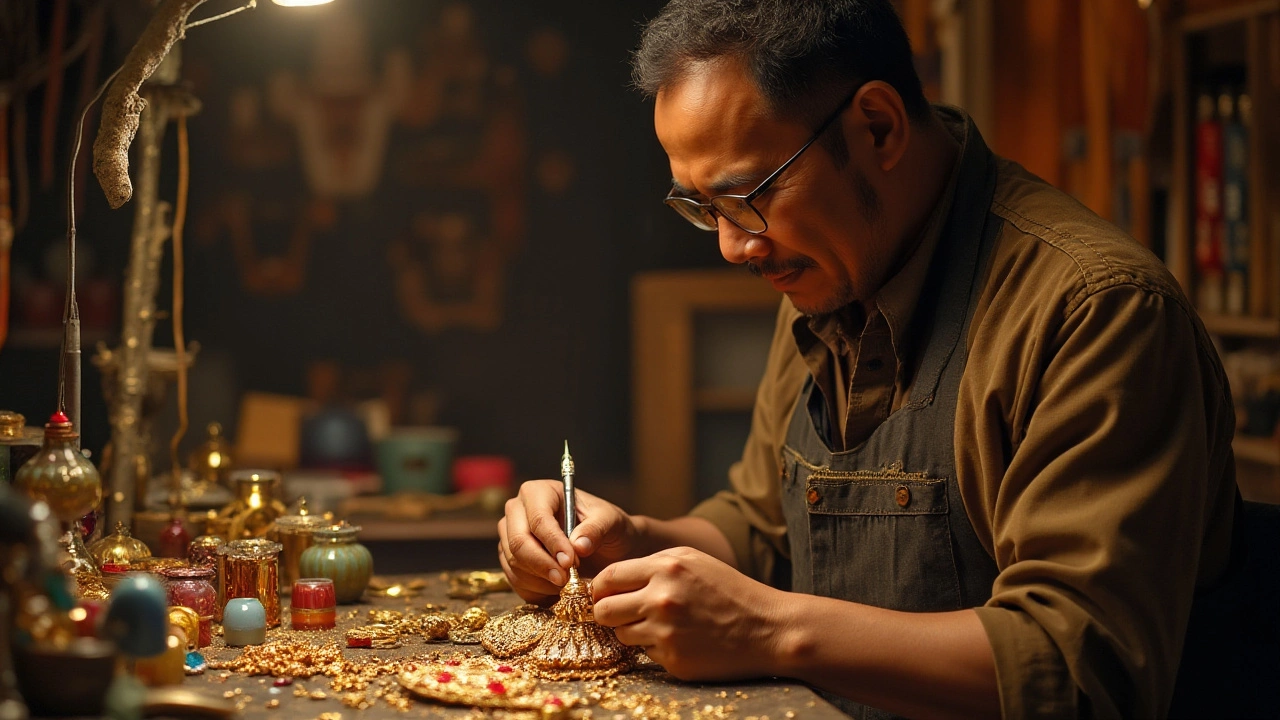
Modern Inspirations and Uses
The beauty and cultural depth of Nakashi jewellery have transcended time, finding a beloved place in both traditional and modern settings. While deeply rooted in history, its relevance today is buoyed largely by the ever-present demand for culturally dignified yet contemporary pieces. Modern designers have gracefully embraced the timeless allure of temple jewellery, merging it seamlessly into today's fashion landscape. This marriage of ancient artistry with modern chic presents individuals with endless possibilities to express their unique style while honoring their heritage.
One of the standout aspects of Nakashi jewellery's modern journey is its versatility. Designers are mixing traditional elements with contemporary materials, creating statements that are both fashionable and meaningful. These eye-catching pieces have been increasingly seen on celebrities, not just in India but across the globe, showcasing their universal appeal. It’s not uncommon to spot a famous personality adorned during an award show, bringing an air of royalty and sophistication. Many modern brides also choose Nakashi pieces to elevate their wedding attire, opting for jewelry that stands as a testament to cultural pride while complementing modern bridal trends.
In recent times, there's been a rise in demand for bespoke jewellery — a trend that Nakashi jewellery caters to beautifully. Modern consumers, characterized by their desire for exclusivity and personalization, often commission these intricate designs for special occasions. Artisans are thus encouraged to innovate within traditional frameworks, presenting bespoke collections that respect their muse's storied past while boldly stepping into the future. This has opened avenues for fusion designs, where traditional goldwork meets vibrant enamel or precious stones, offering a fresh take on age-old artistry.
Nakashi jewellery also thrives in the realm of sustainable fashion. With increased awareness around ethical production, craftsmen are forging paths that emphasize sustainability without sacrificing artistry. This is a commendable shift blending skilled craftsmanship with sustainable practices, appealing to eco-conscious consumers. In alignment with this movement, designers and artisans are making deliberate choices in material sourcing and production that ensures each piece carries forward the legacy responsibly.
Interestingly, the digital landscape has proven fertile ground for Nakashi jewellery to flourish afresh. E-commerce platforms have amplified its reach, allowing enthusiasts from around the world to explore and invest in these treasures. Online showcases and virtual exhibitions have emerged, fostering an appreciation for the detailed craftsmanship that goes into each piece. Many young designers utilize social media and digital campaigns to share the vibrant stories behind their collections, stirring interest and reverence amongst digital natives.
It's often observed that Nakashi jewellery serves not just as adornments but as emotional tokens — bridging the gap between generations, connecting people to their roots while still embracing innovation. As one Indian jewellery expert noted, "Nakashi jewellery is more than just ornamental. It is a tangible piece of history that speaks of our ancestors, their beliefs, and our cultural continuity." These words remind us of the enduring impact jewellery can hold — redefining elegance and meaning with each new wearer. Nakashi jewellery evolves, capturing the zeitgeist at the crossroads of tradition and modernity, continually offering profound beauty and cultural homage.
Tips for Purchasing and Care
When it comes to acquiring a piece of Nakashi jewellery, making an informed choice is key to appreciating its enduring beauty and cultural heritage. First and foremost, it's essential to buy from reputable jewelers with a certified track record of authenticity. This traditional temple jewellery is often crafted by expert artisans who employ time-honored techniques, so verifying the jeweler's credentials helps ensure you're getting a genuine piece. It's also beneficial to assess the craftsmanship closely, examining the intricacy of the designs and the quality of the materials used. Authentic Nakashi pieces are typically made from high-quality gold with embellishments like semi-precious stones or pearls, reflecting the opulence found in historical temple settings.
Understanding the piece's value is equally crucial, particularly because authentic Nakashi jewellery can be a considerable investment. Seek pieces that come with a hallmark certification if possible, as this indicates the purity of the gold used. A hallmark not only assures the buyer of authenticity but also significantly affects the piece's value over time. Additionally, one might consider consulting an appraiser for particularly valuable or unique pieces to ensure the price matches the artisanal craftsmanship and the heritage it represents. An appraiser's insight can often highlight attributes that may not be immediately noticeable to a novice buyer.
Once you have acquired your cherished Nakashi jewellery, proper care is indispensable to preserve its beauty and integrity for years to come. Regular cleaning is needed, but it must be done with caution to protect the delicate detailing that these pieces are renowned for. A gentle cleansing method involves using warm water and mild soap, gently brushing the surface with a soft-bristled toothbrush. Avoid using strong chemicals or ultrasonic cleaners as they can damage the stones and tarnish the gold. After cleaning, ensure to dry the piece thoroughly with a soft cloth, preventing water residue that might dull its shine.
Storing your valuable Nakashi jewels properly is vital to avoid any potential damage. It's recommended to keep each piece separated, ideally in a soft cloth bag or a designated compartment in a jewelry box. This prevents scratches or tangles, particularly since the intricate designs can be fragile. Consider using anti-tarnish strips in the storage containers to keep the gold radiant. For pieces adorned with stones, it's advised to avoid prolonged exposure to direct sunlight as it can potentially fade the stones over time. Regular checks at a professional jeweler can also be beneficial to maintain the jewellery's condition; they can safely handle necessary restorations or adjustments.

